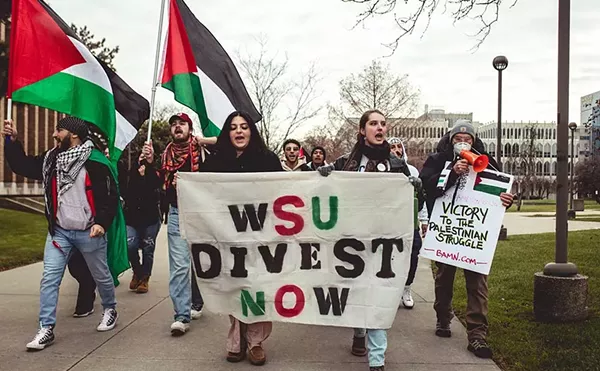Imagine an affirmative action program that could really affect the racial divide. We rebuilt Europe after World War II, didn't we? How about a program on par with the Marshall Plan?
The cost, of course, would be enormous, maybe something like $100 billion over a span of 30 years. That kind of investment could benefit millions who otherwise wouldn't go to college, land good jobs and buy homes. Hundreds of thousands of entrepreneurs might be able to realize their business plans. That kind of spending could create a middle class of a kind never seen before. New suburbs would have to sprout up to accommodate all that buying power.
But as Dave Chappelle might say, oh, snap! — we did have a program just like that. It was called the GI Bill. No one called it an affirmative action program, but as a practical matter it was; it's just that the beneficiaries were disproportionately white and male. And it had a grave impact on the racial divide: It dramatically enlarged it.
The GI Bill was only the largest of a series of programs — all hallowed totems of progressive America — that widened the racial gulf that starts with slavery and haunts us still. The New Deal that helped America weather the Depression, the military expansion that confronted the Axis powers and the Fair Deal that guided postwar America were all crucially shaped by Southern Democrats. High on their agenda, sometimes seemingly their sole agenda, was the preservation of old buddy Jim Crow.
That's the history Columbia University professor Ira Katznelson lays out in When Affirmative Action Was White (W.W. Norton), first published last year and recently issued as a paperback. Katznelson turns the common usage of affirmative action provocatively on its head to make us think about it in a new way. Last week, he was headed to Europe to present a paper, but it's a shame his research and perspective aren't being heard in Michigan as the pivotal vote on affirmative action nears.
"Policy decisions dealing with welfare, work and war during the last hurrah of Jim Crow in the 1930s and 1940s excluded, or differentially treated, the vast majority of African Americans," Katznelson writes. Calling the shots where the new legislation touched on matters of race, Southern Democrats made sure "blacks became even more disadvantaged when a modern American middle class was fashioned before and after the Second World War."
This story gets obscured for several reasons. There is a gauzy nostalgia surrounding this period, the time of "the greatest generation," the time when America pulled together against a common enemy. Nostalgia always comes with a price. In this case, it entails forgetting that "pulling together" included shipping Japanese-Americans off to detention camps. It means forgetting that black Americans, to the extent they were allowed to participate in the war effort, did so in pursuit of "the Double V" — victory over fascists abroad and segregation at home. ("Will Dixie lynch me/When I return?" a "Negro Fighting Man" asked in one Langston Hughes poem of the time.)
Yet the New Deal promised much to black Americans and delivered at least a little. Enough, anyway, to convince black Americans to largely leave the Republicans for the Democrats. W.E.B. DuBois displayed the contradictory feelings of black Americans, crediting Roosevelt for "more uplift and progress of the Negro than any president since Lincoln," and lambasting the New Deal for its abundant shortcomings on race.
Stepping back and using the perspective of a political scientist and a historian, Katznelson sees the cumulative impact of the era's policies "not just as an instrument of racial discrimination but as a perverse formula for affirmative action."
Katznelson is quick to note that he's building on the work of others. He draws from the accounts of the time, like those of DuBois and the African-American press. Writing of the Federal Emergency Relief Act (FERA) of 1934, The Atlanta Daily World said, "The Negro was shown the same place assigned to him at the close of the Civil War, which had for 70 years sealed his illiteracy and poverty." A black FERA administrator, after resigning, said, "the way colored people have suffered under the New Deal ... is a disgrace that stinks to heaven."
Katznelson also draws on scholars who've examined various mosaic pieces of the time, from the implementation of Social Security to the experiences of black soldiers to the treatment of veterans. His contribution is to fit the pieces together and ask what they mean for today.
Each of the individual programs had to pass Congress, where the entrenched Southern Democrats — dominating committee chairmanships in particular — exacted concessions. Excluding as many African-Americans as possible was one tactic; that meant, for instance, cutting what were then heavily African-American jobs such as domestics and farm workers from Social Security when the program began. Local control for programs was a must, meaning Jim Crow administrators in the South. Likewise, anti-discrimination clauses were stripped from the legislation. (One exception to the pattern was the Taft-Hartley Act of 1948. There the Southern Dems split from the party entirely to vote with Republicans and block the spread of unionism below the Mason-Dixon Line. Katznelson argues that the interracial solidarity of unionism was what triggered their opposition. In some ways, the U.S. labor movement never recovered.)
But none of the programs had so large an impact as the GI Bill, which was indeed larger than the Marshall Plan. The higher education provisions alone are telling. In an era when higher education was largely segregated nationwide and rigidly split in the South, black colleges lacked the resources to expand and meet demand. As many as 70,000 black veterans who might have studied were stymied in 1947 alone. From job training to obtaining business loans, the pattern held.
"At no other time in American history have so much money and so many resources been put at the service of the generation completing education, entering the workforce and forming families," Katznelson says of the GI Bill. "With these policies, the Gordian knot binding race to class tightened."
What's to be done now? Katznelson is attuned to the difficulties of using affirmative action to help historically disadvantaged groups. At length, he parses the debate over affirmative action and defends the U.S. Supreme Court decisions that have honed its use since the 1980s and most recently, in the University of Michigan cases of 2003, upheld its legitimacy. He has his own proposals for new programs — from subsidized mortgages to educational grants — for those "in a direct line to people who were harmed" by the programs he concentrates on. They're well worth considering.
But however you view his prescriptions, his diagnosis bears consideration in Michigan today.
It was hard not to think about Katznelson's book the other night as proponents and opponents of the Michigan Civil Rights Initiative squared off in the Southfield Public Library's auditorium. Ben Gurk, a high school history teacher and Iraq war vet defending the MCRI, argued over and over that history is irrelevant to the discussion (except to make affirmative action a slippery slope to totalitarianism).
"I'm sensitive to institutional racism," he said, then asked what could be more "institutionally racist" than the government taking affirmative action to benefit minorities. Considering race, he argued, was "wrong in 1756, 1856, 1956 ... still wrong in 2006." And on it went.
He was simple and to the point — deceptively so.
In Michigan we have programs at colleges, universities and elsewhere that, in their limited way, promote diversity in contrast to our segregated past. Scholars like Katznelson argue that we're still far from even acknowledging that past. Proponents of the MCRI would have us close the book and run from it instead.
W. Kim Heron is editor of Metro Times. Send comments to wkheron@metrotimes.com





